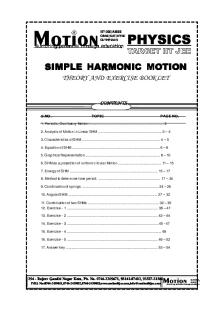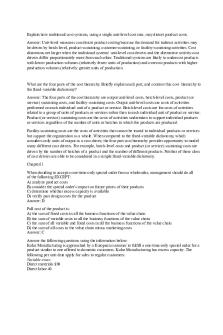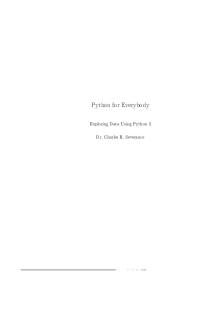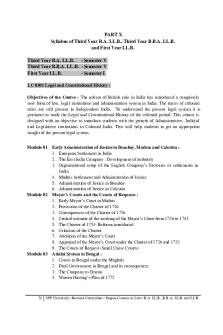Theory-jeemain - nice lectures PDF

| Title | Theory-jeemain - nice lectures |
|---|---|
| Author | Amrita kumari |
| Course | nutricion vegetal |
| Institution | Universidad de las Californias |
| Pages | 35 |
| File Size | 1.5 MB |
| File Type | |
| Total Downloads | 26 |
| Total Views | 169 |
Summary
nice lectures...
Description
II IIT T-JEE -JEE|A |A |AIEE IEE IEEE E CB CBS S E|S E|SA AT | NTS NTSE E OLYMP OLYMPIA IA IADS DS
Nur Nurturing turing poten potential tial th through rough ed education ucation
SI SIMP MP MPLE LE HA HARM RM RMON ON ONIC IC MOTI TION ON THEORY AND EXERCISE BOOKLET
C ON T E N T S S.NO.
TOPIC
PAGE NO.
1. Periodic, Oscillatory Motion ................................................................................ 3 2. Analysis of Motion in Linear SHM .................................................................... 3 – 4 3. Characteristics of SHM .................................................................................... 4 – 5 4. Equation of SHM .............................................................................................. 6 – 8 5. Graphical Representation ................................................................................ 8 – 10 6. SHM as a projection of uniform circular Motion .............................................. 11 – 15 7. Energy of SHM .............................................................................................. 15 – 17 8. Method to determine time period. .................................................................. 17 – 24 9. Combination of springs .................................................................................. 24 – 26 10. Angular SHM ................................................................................................ 27 – 32 11. Combination of two SHMs ............................................................................ 32 – 35 12. Exercise - 1 ................................................................................................. 36 – 41 13. Exercise - 2 ................................................................................................. 42 – 44 14. Exercise - 3 .................................................................................................. 45 - 47 15. Exercise - 4 ..................................................................................................... 48 16. Exercise - 5 ................................................................................................. 49 – 52 17. Answer key .................................................................................................. 53 – 54
394 - Rajeev Gandhi Nagar Kota, Ph. No. 00744-22 744-22 744-2209671, 09671, 93 93141-874 141-874 141-87482, 82, 993527-2 3527-2 3527-21564 1564 IV IVRS RS No: o:074 074 0744-24 4-24 4-2439051, 39051, 39051,074 074 0744-2 4-2 4-24390 4390 439052,0 52,0 52,0744-24 744-24 744-24390 390 39053, 53, 53,www www www.m .m .moti oti otioni oni oniit it itjee jee jee.co .co .com, m, m,inf inf info@motioniitjee. o@motioniitjee. [email protected] com
IIT-JEE |AIEE E CBS E|SAT |NTSE OLYMP IAD S
Nurturing pot ential through education
Page # 2
SIMPLE HARMONIC MOTION
SIMPLE HARMONIC MOTION
Many motions in this universe are periodic i.e., they repeat themselves at regular intervals.
Simple harmonic motion is one of the simplest periodic motion in which an object oscillates
between two spatial positions for an indefinite period of time with no loss of mechanical energy.
In this lesson we will learn about simple harmonic motion in detail. We will calculate
time period of simple harmonic motions in various cases. We will also discuss combination of
simple harmonic motions.
IIT - JEE Syllabus : Linear and angular simple harmonic motions.
394,50 - Rajeev Gandhi Nagar Kota, Ph. No. : 93141-87482, 0744-2209671 IVRS No : 0744-2439051, 52, 53, www. motioniitjee.com, [email protected]
Page # 3
SIMPLE HARMONIC MOTION
1.
PERIODIC MOTION : When a body or a moving particle repeats its motion along a definite path after regular intervals of time its motion is said to be Periodic Motion and interval of time is called time period (T). The path of periodic motion may be linear, circular, elliptical or any other curve. For example rotation of earth around the sun.
2.
OSCILLATORY MOTION : To and fro type of motion is called Oscillatory Motion. A particle has oscillatory motion when it moves about stable equilibrium position. It need not be periodic and need not have fixed extreme positions. The oscillatory motions in which energy is conserved are also periodic.For example motion of pendulum of a wall clock. The force / torque (directed towards equillibrium point) acting in oscillatory motion is called restoring force/torque Damped Oscillations are those in which energy consumed due to some resistive forces and hence total mechanical energy decreases and after some time oscillation will stop. Oscillatory Equation : Consider a particle free to move on x-axis is being acted upon by a force given by F = – kxn Above equation is called oscillatory equation. Here k is a positive constant and x is the displacement from mean position Now following cases are possible depending on the value of n.
(i)
If n is an even interger (0, 2, 4......... etc)n force is always along negative x-axis whether x is positive or negative Hence, the motion of the particle is not oscillatory. If the particle is released from any position on the x-axis (except x = 0) a force in – ve direction of x-axis acts on it and it moves rectilinearly along – ve x axis.
(ii)
If n is an odd integer (1, 3, 5 ........... etc), force is along – ve x-axis for x > 0 and along +ve x-axis for x < 0 and zero for x = 0. Thus the particle will oscillate about stable equillibrium position x = 0. The force in this case is called the restoring force. If n = 1 i.e., F = – kx the motion is said to be SHM (Simple Harmonic Motion) If the restoring force / torque acting on the body in oscillatory motion is directly proportional to the displacement of body / particle w.r.t. mean position and is always directed towards equillibrium position then the motion is called Simple Harmonic motion. It is the simplest form of oscillatory motion.
3.
TYPES OF SHM : (a) Linear SHM : When a particle moves to and fro about an equilibrium point, along a straight line here A and B are extreme positions and M is mean position so AM = MB = Amplitude. M B A (b) Angular SHM : When body/particle is free to rotate about a given axis and executing angular oscillations.
4.
ANALYSIS OF MOTION IN LINEAR SHM : When the particle is moved away from the mean position or equillibrium position and released, a force (–kx) comes into play to pull it back towards mean position. By the time it gets at mean position it has picked up some kinetic energy and so it overshoots, stopping some where on the other side and it is again pulled back towards the mean position. It is necessary to study the change in speed and acceleration of particle during SHM. Let us
394,50 - Rajeev Gandhi Nagar Kota, Ph. No. : 93141-87482, 0744-2209671 IVRS No : 0744-2439051, 52, 53, www. motioniitjee.com, [email protected]
Page # 4
SIMPLE HARMONIC MOTION
consider a particle whose position is x = 0 at t = 0 and v = v0. Then we divide the motion of particle in one time period in four parts. Mean Extreme extreme Position position position v=v 0 A
B v=0
v=0 C
Amplitude x=0 (A) from A to B
t=0
(B) from B to A
x (C) from A to C
(D) from C to A
NOTE :In the figure shown, path of the particle is a straight line. (1)
Motion of a particle from A to B : Initially the particle is at A (mean position) and is moving towards +ve x direction with speed v0. As the particle is moving towards B, force acting on it towards A is increasing. Consequently its acceleration towards A is increasing in magnitude while its speed decreases and finally it comes to rest momentarily at B.
(2)
Motion of a particle from B to A : Now the particle starts moving towards A with initial speed v = 0. As the particle is moving towards A, force is acting on it towards A and decreasing as it approaches A. Consequently its acceleration towards A is decreasing in magnitude while its speed increases and finally it comes to A with same speed v = v0.
(3)
Motion of a particle from A to C : The motion of a particle from A to C is qualitatively same as motion of a particle from A to B.
(4)
Motion of a particle from C to A : It is qualitatively same as motion of a particle from B to A.
Summary : Motion from
Velocity (Direction/Magnitude)
Acceleration (Direction/ Magnitude)
AB
V
a
BA
V
a
AC
V
a
CA
V
a
5.
CHARACTERISTICS OF SHM :
(1) (2)
Mean Position : It is the position where net force on the particle is zero. Extreme Point : Point where speed of the particle is zero.
(3)
Displacement : It is defined as the distance of the particle from the mean position at that instant.
(4)
Amplitude : It is the maximum value of displacement of the particle from its mean position.
394,50 - Rajeev Gandhi Nagar Kota, Ph. No. : 93141-87482, 0744-2209671 IVRS No : 0744-2439051, 52, 53, www. motioniitjee.com, [email protected]
Page # 5
SIMPLE HARMONIC MOTION Extreme position – Mean position = Amplitude. It depends upon the energy of the system. (5)
Frequency : The frequency of SHM is equal to the number of complete oscillations per unit time. f
(6)
1 sec –1 or Hz. T 2
Time Period : Smallest time interval after which the oscillatory motion gets repeated is called time period. T=
Ex.1
Sol.
2
Describe the motion of a particle acted upon by a force. (A) F = 3x + 3 = 3x – 3
(B) F = – 3x – 3
(a) Given F = 3x + 3
...(i)
(C) F = – 3x + 3
(D) F
We find the mean position at which net force on the particle is zero.
3x + 3 = 0
x=–1
If we put x = 0 in eq. (i) then F = 3N (away from M.P.)
M.P. ...(a)
x = –1
Now put x = –2 in eq. (i) F=– 3N
(away from M.P.)
...(b)
From (a) and (b) we conclude that particle doesn't perform S.H.M. (b) Given F = – 3x – 3
...(i)
at M.P. F = 0
x = –1
F = – 3N (towards M.P.)
Now put x = 0 in eq. (i) If x = – 2 ; F = 3N (towards M.P.) We conclude from the above calculation that in every case (whether the particle is left from M.P. or right from M.P.) force acts towards M.P. so the particle performs S.H.M. (c)
Given F = – 3x + 3 when
F=0
x = 1 (M.P.) Now put x = 0 Then F = 3N
(towards M.P.)
If x = 2
F=–3
(towards M.P.)
i.e. particle performs S.H.M. (D)
Given F = 3x – 3 Mean position at x = 1. When x = 0 ; F = – 3N x = 2 ; F = 3N
(away from M.P.) (away from M.P.)
Particle doesn't perform S.H.M.
394,50 - Rajeev Gandhi Nagar Kota, Ph. No. : 93141-87482, 0744-2209671 IVRS No : 0744-2439051, 52, 53, www. motioniitjee.com, [email protected]
Page # 6
6.
SIMPLE HARMONIC MOTION
EQUATION OF SIMPLE HARMONIC MOTION : The necessary and sufficient condition for SHM is F = – kx we can write above equation in the following way: ma = – kx m
d2 x –kx dt 2
d 2x k x 0 dt2 m
...(1)
Equation (1) is Double Differential Equation of SHM. Now
d 2x 2 x 0 dt2
It's solution is x = A sin(t ) k m
where = angular frequency =
x = displacement from mean position k = SHM constant. The equality (t + ) is called the phase angle or simply the phase of the SHM and is the initial phase i.e., the phase at t = 0 and depends on initial position and direction of velocity at t = 0. To understand the role of in SHM, we take two particles performing SHM in the following condition:
v0
A
M.P.
–A
x –A
M.P.
A
x
figure II
figure I
Suppose we choose t = 0 at an instant when the particle is passing through its mean position towards right (i.e.positive direction) as shown in figure I st then In figure I
at
t=0
x=0
i.e., x = A sin t The particle is at its mean position. In figure II i.e.,
at
t=0
x = A and the particle is moving towards the mean position.
x = A sin ( t + /2)
Here /2 is the only phase possible.
394,50 - Rajeev Gandhi Nagar Kota, Ph. No. : 93141-87482, 0744-2209671 IVRS No : 0744-2439051, 52, 53, www. motioniitjee.com, [email protected]
Page # 7
SIMPLE HARMONIC MOTION
Ex.2
A particle starts from mean position and moves towards positive extreme as shown below. Find the equation of the SHM. Amplitude of SHM is A. t=0 O
–A
Sol.
A
General equation of SHM can be written as x = A sin (t + ) At t = 0, x = 0 0 = A sin = 0, [0, 2) Also; at t = 0, v = + ve A cos = + ve or, =0 Hence, if the particle is at mean position at t = 0 and is moving towards +ve extreme, then the equation of SHM is given by x = A sin t. Similarly for particle moving towards –ve extreme then t=0
–A
+A = equation of SHM is x = A sin (t + ) or, x = – A sin t
Ex.3
Write the equation of SHM for the situation shown below :
Sol.
t=0 A O A/2 General equation of SHM can be written as x = A sin ( t + ) At t = 0, x = A/2
–A
A = A sin 2
= 30° , 150° Also at t = 0, v = – ve A cos = – ve 7.
= 150°
VELOCITY : It is the rate of change of particle displacement with respect to time at that instant. Let the displacement from mean position is given by x = A sin (t + ) velocity
v
dx A cos( t ) dt
v = A cos ( t + ) v = A2 – x2 At mean position (x = 0), velocity is maximum. Vmax = A At extreme position (x = A), velocity is minimum. vmin = zero.
394,50 - Rajeev Gandhi Nagar Kota, Ph. No. : 93141-87482, 0744-2209671 IVRS No : 0744-2439051, 52, 53, www. motioniitjee.com, [email protected]
Page # 8 7.1
SIMPLE HARMONIC MOTION
Graph of Velocity (v) V/S Displacement (x) :
v 2 2 ( A 2 – x 2 )
v A2 – x2
v2
v 2 2 x 2 2 A 2
2
A
2
x2 A2
A
1
Graph would be a half ellipse. 8.
Velocity (v)
–A
A
x
ACCELERATION : It is the rate of change of particle's velocity w.r.t. time at that instant. Acceleration, a
d dv [ A cos( t )] = dt dt
a = – 2A sin (t + ) a = – 2 x Note : Negative sign shows that acceleration is always directed towards the mean position. At mean position (x =0), acceleration is minimum. amin = zero At extreme position (x = A), acceleration is maximum. |amax | = 2A 8.1
Graph of Acceleration (A) v/s Displacement (x):
a 2A A –A
a=–x 2
x
– 2 A
9.
GRAPHICAL REPRESENTATION OF DISPLACEMENT, VELOCITY & ACCELERATION IN SHM: Displacement, x = A sin t Velocity,
v = A cos t = A sin ( t ) 2
or
v A 2 – x2
Acceleration, a = – 2A sin t = 2A sin ( t + ) or
a = – 2 x
Note : •
v A 2 – x2 a = – 2x
These relations are true for any equation of x.
394,50 - Rajeev Gandhi Nagar Kota, Ph. No. : 93141-87482, 0744-2209671 IVRS No : 0744-2439051, 52, 53, www. motioniitjee.com, [email protected]
Page # 9
SIMPLE HARMONIC MOTION
x
T/4
T/2 3T/4 T
5T/4 3T/2
A t –A v A t – A a 2A t – 2 A
Ex.4
Sol.
1.
All the three quantities displacement, velocity and acceleration vary harmonically with time, having same period.
2.
The maximum velocity is times the amplitude (Vmax = A).
3.
The acceleration is 2 times the displacement amplitude (amax = 2A).
4.
In SHM, the velocity is ahead of displacement by a phase angle of
5.
In SHM, the acceleration is ahead of velocity by a phase angle of
. 2 . 2
The equation of particle executing simple harmonic motion is x (5m)sin( s –1)t . 3 Write down the amplitude, time period and maximum speed. Also find the velocity at t = 1 s.
Comparing with equation x = A sin ( t + ), we see that the amplitude = 5m, and time period =
2 2 2s = s–1
The maximum speed = A = 5 m × s–1 = 5 m/s The veloity at time t At
dx = A cos ( t + ) dt
t = 1 s, 5 m/s v = (5 m) ( s–1) cos = – 2 3
394,50 - Rajeev Gandhi Nagar Kota, Ph. No. : 93141-87482, 0744-2209671 IVRS No : 0744-2439051, 52, 53, www. motioniitjee.com, [email protected]
Page # 10
SIMPLE HARMONIC MOTION
Ex.5
A particle executing simple harmonic motion has angular frequency 6.28 s–1 and amplitude 10 cm. Find (a) the time period, (b) the maximum speed, (c) the maximum acceleration, (d) the speed when the displacement is 6 cm from the mean position, (e) the speed at t = 1/6 s assuming that the motion starts from rest at t = 0.
Sol.
(a) Time period =
2 2 = s = 1 s. 6.28 (b) Maximum speed = A = (0.1m) (6.28 s–1) (c) Maximum acceleration = A2 = (0.1m) (6.28 s–1)2 = 4 m/s2
(d) v A 2 – x 2 = (6.28 s–1)
(10cm)2 – (6cm)2 = 50.2 cm/s.
(e) At t = 0, the velocity is zero i.e., the particle is at an extreme. The equation for displacement may be written as x = A cos t. The velocity is v = – A sin t. At t
6.28 v = – (0.1 m) (6.28 s–1) sin 6
1 s, 6
= – 54.4 cm/s. (towards mean position) 3 Note : If mean position is not at the origin, then we can replace x by x – x0 and the eqn. becomes
= (–0.628 m/s) sin
x – x0 = – A sin t, where x0 is the position co-ordinate of the mean position. Ex.6
A particle of mass 2 kg is moving on a straight line under the action force F = (8 – 2x) N. It is released at rest from x = 6m. (A) Is the particle moving simple harmonically? (B) Find the equilibrium position of the particle. (C) Write the equation of motion of the particle. (D) Find the time period of SHM.
Sol.
F = 8 – 2x or
F = –2(x – 4)
for equilibrium position F = 0
x = 4m is equilibrium position.
Hence the motion of particle is SHM with force constant 2 and equilibrium position x =4. (a) Yes, motion is SHM. (b) Equilibrium positio...
Similar Free PDFs

Theory-jeemain - nice lectures
- 35 Pages

Ch11 - nice
- 16 Pages

Pythonlearn - Nice
- 249 Pages

A3P1 - Nice
- 13 Pages

Unit1 - NICE
- 58 Pages

Naasa - Nice
- 4 Pages

Etech 2 - NICE
- 85 Pages

Dokument bez tytułu - nice
- 9 Pages

Manuale- NICE - BIO-FLO
- 1 Pages

Amcat automata 5 - Nice
- 2 Pages

Llb syllabus 1 - Nice
- 4 Pages

Semana 6 - Nice
- 2 Pages

(Notes) FAR Summary (NICE)
- 48 Pages

Scp extra - nice
- 3 Pages

Haha sohai - nice
- 23 Pages

Bronze Science - nice
- 2 Pages
Popular Institutions
- Tinajero National High School - Annex
- Politeknik Caltex Riau
- Yokohama City University
- SGT University
- University of Al-Qadisiyah
- Divine Word College of Vigan
- Techniek College Rotterdam
- Universidade de Santiago
- Universiti Teknologi MARA Cawangan Johor Kampus Pasir Gudang
- Poltekkes Kemenkes Yogyakarta
- Baguio City National High School
- Colegio san marcos
- preparatoria uno
- Centro de Bachillerato Tecnológico Industrial y de Servicios No. 107
- Dalian Maritime University
- Quang Trung Secondary School
- Colegio Tecnológico en Informática
- Corporación Regional de Educación Superior
- Grupo CEDVA
- Dar Al Uloom University
- Centro de Estudios Preuniversitarios de la Universidad Nacional de Ingeniería
- 上智大学
- Aakash International School, Nuna Majara
- San Felipe Neri Catholic School
- Kang Chiao International School - New Taipei City
- Misamis Occidental National High School
- Institución Educativa Escuela Normal Juan Ladrilleros
- Kolehiyo ng Pantukan
- Batanes State College
- Instituto Continental
- Sekolah Menengah Kejuruan Kesehatan Kaltara (Tarakan)
- Colegio de La Inmaculada Concepcion - Cebu